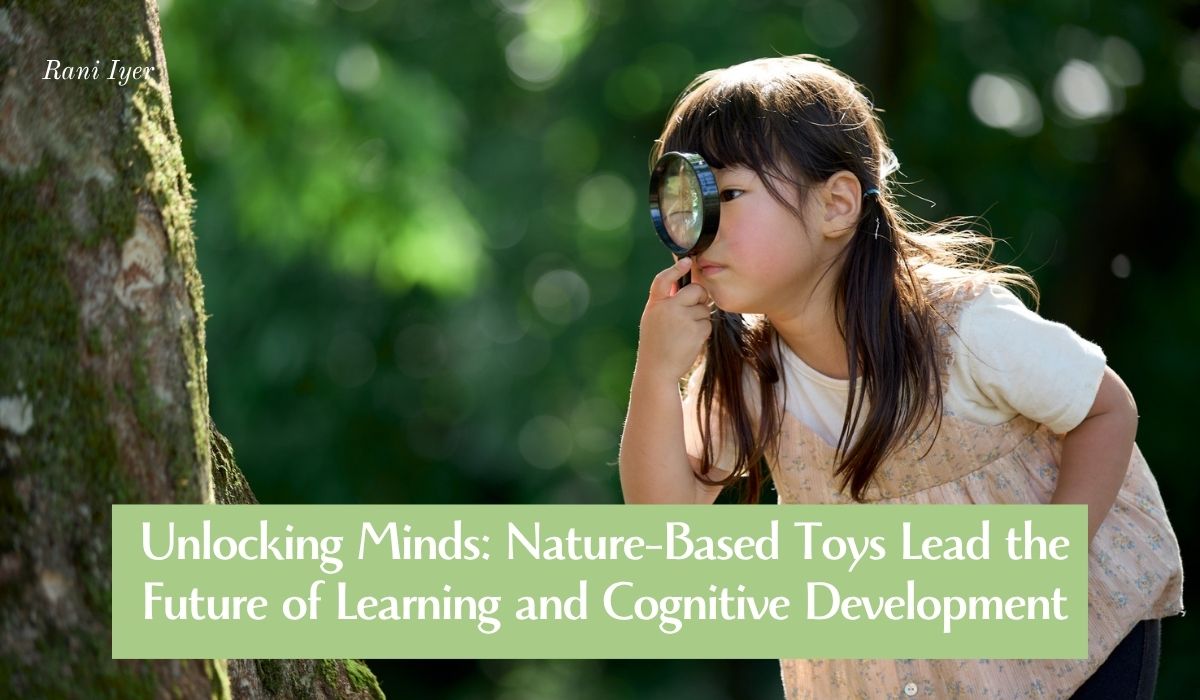In a world increasingly dominated by screens, the return to nature-based toys is not just a nostalgic trend—it’s a powerful movement reshaping how children learn and develop. These innovative tools harness the wonders of the natural world, encouraging young minds to explore, imagine, and create. By intertwining play with nature, we’re unlocking cognitive potential that traditional toys often overlook. Nature-based toys stimulate curiosity and foster problem-solving skills while nurturing an appreciation for the environment. As educators and parents seek new methods to enhance learning experiences, these toys represent a promising approach to cognitive development. Join us as we delve into how these enchanting, earth-inspired creations are not only captivating children’s imaginations but also laying the groundwork for a future where learning is as natural as the world around us. The journey towards unlocking minds begins here!
The Importance of Play in Cognitive Development
Play is an essential part of childhood and a cornerstone of cognitive development. When children engage in play, they aren’t just having fun; they are actively learning and building crucial skills that will serve them throughout their lives. From problem-solving to social interaction, play allows children to explore their world, practice new abilities, and understand complex concepts in an intuitive manner. It is through play that children learn to navigate their environment, make decisions, and develop a sense of agency.
Cognitive development during play is multifaceted. For instance, when a child stacks blocks, they are not only honing their fine motor skills but also engaging in spatial reasoning and understanding cause and effect. Similarly, role-playing scenarios help children develop language skills, empathy, and the ability to see things from different perspectives. These activities, while seemingly simple, lay the groundwork for advanced cognitive functions and critical thinking.
Moreover, play has been shown to have a profound impact on brain development. Studies indicate that playful experiences stimulate the production of brain-derived neurotrophic factor (BDNF), a protein crucial for the growth and differentiation of new neurons and synapses. This biological process underscores the importance of play in enhancing memory, improving attention, and fostering learning. As such, integrating play into educational frameworks is not just beneficial but necessary for holistic cognitive development.
How Nature-Based Toys Enhance Learning Experiences
Nature-based toys take the intrinsic benefits of play a step further by integrating elements of the natural world. These toys, made from natural materials like wood, stone, and fibers, bring the textures, colors, and forms of nature into playtime. This connection to nature stimulates the senses in ways that synthetic toys often cannot, creating a richer and more immersive learning experience.
One key advantage of nature-based toys is that they encourage open-ended play. Unlike electronic toys that often dictate how they should be used, nature-based toys invite children to use their imagination and creativity. A simple set of wooden blocks, for example, can become anything from a castle to a spaceship, depending on the child’s vision. This kind of imaginative play is crucial for developing problem-solving skills, as children must figure out how to bring their ideas to life using the materials at hand.
Furthermore, nature-based toys often have educational value embedded in their design. Toys made from natural materials can teach children about the environment, sustainability, and the importance of preserving our natural resources. For instance, a nature-based puzzle featuring various animal species can spark a child’s interest in biology and conservation. By making learning fun and engaging, these toys can instill a lifelong love of nature and science.
The Psychological Benefits of Nature Exposure
The psychological benefits of exposure to nature are well-documented and profound. Interaction with the natural environment has been shown to reduce stress, enhance mood, and improve overall mental well-being. For children, these benefits are particularly significant, as their developing brains are highly receptive to the calming and restorative effects of nature.
Nature-based toys serve as a bridge to the outdoors, bringing elements of the natural world into everyday play. This connection can have a soothing effect on children, helping to reduce anxiety and promote a sense of tranquility. The tactile experience of handling natural materials—like the smooth surface of a wooden toy or the rough texture of a stone—can also be therapeutic, enhancing sensory development and grounding children in the present moment.
In addition to reducing stress, nature exposure through play can improve focus and attention. Research has shown that children who spend time in natural settings tend to have better concentration and are more capable of completing tasks. This phenomenon, often referred to as the “restorative effect” of nature, is believed to occur because natural environments provide a break from the constant stimuli and demands of modern life, allowing the mind to rest and recharge.
Moreover, nature-based play can foster a deep sense of connection to the environment. When children interact with nature-based toys, they develop an appreciation for the beauty and complexity of the natural world. This connection can inspire a sense of stewardship and responsibility, encouraging children to care for the environment and understand their role in preserving it for future generations.
Types of Nature-Based Toys and Their Educational Value
Nature-based toys come in a diverse array of forms, each offering unique educational benefits. Wooden toys, for example, are timeless classics that provide a tactile and durable play experience. From building blocks to intricate puzzles, wooden toys can enhance fine motor skills, spatial reasoning, and problem-solving abilities. Their natural texture and weight also provide sensory stimulation that is both satisfying and calming.
Stone and mineral-based toys are another category that captivates children’s curiosity. These toys, often used in educational settings, can teach children about geology, mineralogy, and the natural processes that shape our planet. Collections of polished stones or mineral samples can be used for sorting, classification, and examination under magnifying glasses, turning playtime into a scientific exploration.
Nature-inspired art supplies, such as beeswax crayons or plant-based paints, encourage creativity while promoting environmental consciousness. These materials are often biodegradable and non-toxic, making them safe for children and the planet. By using natural art supplies, children can learn about sustainable practices and the importance of using resources responsibly.
Outdoor exploration kits are also a valuable addition to the nature-based toy repertoire. These kits, which may include items like magnifying glasses, bug catchers, and plant identification guides, encourage children to venture outside and engage directly with the natural world. This hands-on approach to learning fosters observation skills, scientific inquiry, and a sense of adventure.
Integrating Nature-Based Toys into Early Childhood Education
Integrating nature-based toys into early childhood education can transform the learning environment into a dynamic and engaging space. Early childhood is a critical period for cognitive and emotional development, and incorporating natural elements into the classroom can enhance educational outcomes in numerous ways.
One effective method is to create a nature-themed learning corner within the classroom. This space can be filled with nature-based toys, natural objects like pinecones and leaves, and educational materials related to the environment. Children can explore this corner during free play, using the natural materials to build, create, and engage in imaginative play. This setup not only enriches the learning experience but also fosters a connection to nature within the educational setting.
Outdoor classrooms and nature-based curriculums are another innovative approach. Schools that incorporate outdoor learning experiences, such as garden-based education or nature walks, provide children with direct exposure to the natural world. These experiences can be supplemented with nature-based toys that children can use to explore and interact with their surroundings. For example, children might use magnifying glasses to examine plants and insects or create nature art using leaves and flowers. These activities promote hands-on learning and encourage children to observe, question, and discover.
Professional development for educators is also crucial in successfully integrating nature-based toys into the curriculum. Teachers need to be equipped with the knowledge and skills to effectively use these tools in their teaching. Workshops and training sessions can provide educators with practical strategies for incorporating nature-based play into their lesson plans, as well as the theoretical background on the benefits of nature-based learning. By empowering teachers, schools can create a more holistic and nature-centric educational experience for their students.
Case Studies: Success Stories of Nature-Based Learning
Numerous case studies highlight the success of nature-based learning and the positive impact it has on children’s cognitive and emotional development. One notable example is the Forest School movement, which originated in Scandinavia and has since spread globally. Forest Schools emphasize outdoor, experiential learning, where children spend significant time in natural environments, engaging in activities like building shelters, identifying plants, and navigating terrain. Research on Forest Schools has shown that children who participate in these programs exhibit improved social skills, increased confidence, and enhanced problem-solving abilities.
Another success story comes from the Green School in Bali, Indonesia. This innovative school is built entirely from sustainable materials and integrates nature into every aspect of the curriculum. Students engage in hands-on environmental projects, such as organic farming and renewable energy initiatives, alongside traditional academic subjects. The immersive nature-based approach of the Green School has been praised for fostering a deep sense of environmental stewardship and producing graduates who are not only academically competent but also passionate about sustainability.
In urban settings, programs like the Nature Preschool at the Schlitz Audubon Nature Center in Milwaukee, Wisconsin, demonstrate how nature-based learning can be successfully implemented even in city environments. This preschool incorporates daily outdoor exploration into its curriculum, allowing children to learn through direct interaction with nature. Studies on the Nature Preschool have shown that children develop strong observational skills, creativity, and a profound connection to the natural world.
These case studies illustrate that nature-based learning is not limited by geography or resources. Whether in a dense city or a rural area, integrating nature into education can provide children with a rich, multifaceted learning experience that supports their cognitive and emotional growth.
Tips for Parents: Choosing the Right Nature-Based Toys
For parents looking to introduce nature-based toys into their children’s playtime, there are several factors to consider to ensure the toys are both educational and engaging. First and foremost, consider the materials used in the toys. Opt for items made from natural, sustainable materials like wood, stone, or organic fibers. These materials are not only environmentally friendly but also provide a tactile experience that synthetic toys cannot match.
It’s also important to choose toys that encourage open-ended play. Look for toys that can be used in multiple ways and do not have a fixed purpose. This allows children to use their imagination and creativity, turning a simple set of wooden blocks into a castle, a bridge, or anything else they can dream up. Open-ended toys support cognitive development by challenging children to think critically and solve problems.
Consider the educational value of the toys as well. Nature-based toys that incorporate elements of science, art, or environmental education can enhance learning and spark curiosity. For example, a set of animal figurines made from natural materials can teach children about different species and their habitats, while plant-based art supplies can introduce concepts of sustainability and resource use.
Lastly, involve your children in the selection process. Allow them to explore different nature-based toys and choose the ones that interest them the most. This not only ensures that the toys will be engaging but also empowers children to take an active role in their own learning and development.
The Future of Learning: Trends in Nature-Based Play
As we look to the future, the trend towards nature-based play is poised to continue growing, driven by a growing recognition of the benefits it offers for cognitive and emotional development. One emerging trend is the integration of technology with nature-based play. While this may seem counterintuitive, innovative approaches are finding ways to blend the digital and natural worlds in a harmonious way. For instance, augmented reality (AR) apps that encourage outdoor exploration and learning can enhance the nature-based play experience without overshadowing it.
Another trend is the rise of eco-conscious toy manufacturing. As awareness of environmental issues increases, more toy companies are adopting sustainable practices, using renewable materials, and reducing waste. This shift not only benefits the planet but also aligns with the educational values of nature-based play, teaching children about sustainability from a young age.
Community-driven initiatives are also on the rise, with local groups and organizations creating nature-based play spaces and programs. These community efforts provide accessible opportunities for children to engage with nature, regardless of their socioeconomic background. By fostering a sense of community and connection to the environment, these initiatives support holistic development and promote social cohesion.
The future of learning is one that embraces the natural world, recognizing that the best lessons are often found outside the classroom. By continuing to innovate and integrate nature-based play into education, we can create a generation of learners who are not only intellectually capable but also deeply connected to the environment and committed to sustainability.
Conclusion: Embracing Nature for Holistic Development
In conclusion, nature-based toys represent a powerful tool for shaping the future of learning and cognitive development. By integrating elements of the natural world into play, these toys offer a rich, sensory experience that supports cognitive growth, emotional well-being, and environmental consciousness. They encourage open-ended play, foster creativity, and teach valuable lessons about sustainability and the natural world.
For educators and parents, the benefits of incorporating nature-based toys into children’s lives are clear. These toys not only enhance learning and development but also instill a lifelong appreciation for nature and a sense of responsibility towards the environment. As we move towards a future where learning is as natural as the world around us, embracing nature-based play is a crucial step in unlocking the full potential of young minds.
The journey towards holistic development begins with the simple act of play. By choosing nature-based toys and creating opportunities for children to connect with the natural world, we can nurture a generation of curious, creative, and environmentally conscious individuals. The path to unlocking minds is paved with the wonders of nature, and the adventure begins now.


